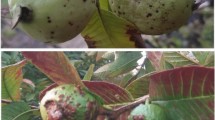Abstract
Banana Xanthomonas wilt, caused by Xanthomonas campestris pv. musacearum, is a new threat to banana cultivation in eastern Africa. The causal bacterium grows slowly in culture and is easily overgrown by contaminants. A selective culture medium for isolation of X. c. pv. musacearum will facilitate disease study. A medium that suppressed saprophytic growth and possessed diagnostic characters for the pathogen was developed. Various carbon sources were tested with two isolates of X. c. pv. musacearum, and sucrose was selected as main carbon source. The susceptibility of X. c. pv. musacearum and other bacterial strains was tested with 29 different antibiotics. Cephalexin and cycloheximide had no effect on X. c. pv. musacearum but cephalexin inhibited most of the saprophytes and cycloheximide inhibited the fungal contaminants. Based on these studies, we have developed a semi-selective medium YTSA-CC containing yeast extract (1%), tryptone (1%), sucrose (1%), agar (1.5%), cephalexin (50 mg l−1) and cycloheximide (150 mg l−1), pH 7.0. The pathogen X. c. pv. musacearum was easily identified as yellowish, mucoid and circular colonies on YTSA-CC medium. This simple semi-selective medium was effective for isolation of X. c. pv. musacearum from infected banana tissues and soil, and it should be a valuable tool in ecological and epidemiological studies.

Similar content being viewed by others
References
Bryan, L. E., & Godfrey, A. J. (1991). β-lactam antibiotics: mode of action and bacterial resistance. In V. Lorian (Ed.), Antibiotics in laboratory medicine (pp. 599–664). Baltimore, USA: Williams & Wilkins.
Claflin, L. E., Vidaver, A. K., & Sasser, M. (1987). MXP, a semiselective medium for Xanthomonas campestris pv. phaseoli. Phytopathology, 77, 730–734.
Davis, M. J., Rott P., Baudin, P., & Dean, J. L. (1994). Evaluation of selective media and immunoassays for detection of Xanthomonas albilineans, causal agent of sugarcane leaf scald disease. Plant Disease, 78, 78–82.
Di, M., Ye, H., Schaad, N. W., & Roth, D. A. (1991). Selective recovery of Xanthomonas spp. from rice seed. Phytopathology, 81, 1358–1363.
Eden-Green, S. (2004). How can the advance of banana Xanthomonas wilt be halted? Infomusa, 13, 38–41.
Fessehaie, A., Wydra, K., & Rudolph, K. (1999). Development of a new semiselective medium for isolating Xanthomonas campestris pv. manihotis from plant material and soil. Phytopathology, 89, 591–597.
Mabagala, R. B., & Saettler, A. W. (1992). An improved semiselective medium for recovery of Xanthomonas campestris pv. phaseoli. Plant Disease, 76, 443–446.
Mohan, S. K., & Schaad, N. W. (1987). An improved agar plating assay for detecting Pseudomonas syringae pv. syringae and P. syringae pv. phaseolicola in contaminated bean seed. Phytopathology, 77, 1390–1395.
Ndungo, V., Eden-Green, S., Blomme, G., Crozier, J., & Smith, J. (2005). Presence of banana xanthomonas wilt (Xanthomonas campestris pv. musacearum) in the Democratic Republic of Congo (DRC). New Disease Reports, 11, http://www.bspp.org.uk/ndr/july2005/2005-29.asp.
Norman, D. J., & Alvarez, A. M. (1994). Rapid detection of Xanthomonas campestris pv. dieffenbachiae in anthurium plants with a miniplate enrichment/ELISA system. Plant Disease, 78, 954–958.
Randhawa, P., & Schaad, N. W. (1984). Selective isolation of Xanthomonas campestris pv. campestris from crucifer seeds. Phytopathology, 74, 268–272.
Rhee, D. K., Lee, S. B., Rhee, J. S., Ryu, D. D. Y., & Hospodka, J. (1980). Enzymatic biosynthesis of cephalexin. Biotechnology and Bioengineering, 22, 1237–1247.
Roumagnac, P., Gagnevin, L., & Pruvost, O. (2000). Detection of Xanthomonas sp., the causal agent of onion bacterial blight, in onion seeds using a newly developed semi-selective isolation medium. European Journal of Plant Pathology, 106, 867–877.
Schaad, N. W., & Forster, R. L. (1985). A semi-selective agar medium for isolating Xanthomonas campestris pv. translucens from wheat seeds. Phytopathology, 75, 260–263.
Schaad, N. W., & Stall, R. E. (1988). Xanthomonas. In N. W. Schaad (Ed.), Laboratory guide for identification of plant pathogenic bacteria (2nd ed., pp. 81–94). St Paul, MN, USA: APS.
Sijam, K., Chang, C. J., & Gitaitis, R. D. (1992). A medium for differentiating tomato and pepper strains of Xanthomonas campestris pv. vesicatoria. Canadian Journal of Plant Pathology, 14, 182–184.
Tushemereirwe, W., Kangire, A., Ssekiwoko, F., Offord, L. C., Crozier, J., Boa, E., Rutherford, M., & Smith, J. J. (2004). First report of Xanthomonas campestris pv. musacearum on banana in Uganda. Plant Pathology, 53, 802.
Weng, S. F., Chen, C. Y., Lee, Y. S., Lin, J. W., & Tseng, Y. H. (1999). Identification of a novel beta-lactamase produced by Xanthomonas campestris, a phytopathogenic bacterium. Antimicrobial Agents and Chemotherapy, 43, 1792–1797.
Wydra, K., Khatri-Chetri, G., Mavridis, A., Sikirou, R., & Rudolph, K. (2004). A diagnostic medium for the semi-selective isolation and enumeration of Xanthomonas axonopodis pv. vignicola. European Journal of Plant Pathology, 110, 991–1001.
Yirgou, D., & Bradbury, J. F. (1974). A note on wilt of banana caused by the enset wilt organism Xanthomonas musacearum. East African Agricultural and Forestry Journal, 40, 111–114.
Acknowledgements
We wish to express our appreciation to Fred Ssekiwoko for providing bacterial cultures, Henry Wagaba for technical assistance, John Odipo for data analysis and The Gatsby Charitable Foundation for funding.
Author information
Authors and Affiliations
Corresponding author
Rights and permissions
About this article
Cite this article
Tripathi, L., Tripathi, J.N., Tushemereirwe, W.K. et al. Development of a semi-selective medium for isolation of Xanthomonas campestris pv. musacearum from banana plants. Eur J Plant Pathol 117, 177–186 (2007). https://doi.org/10.1007/s10658-006-9083-7
Received:
Accepted:
Published:
Issue Date:
DOI: https://doi.org/10.1007/s10658-006-9083-7




